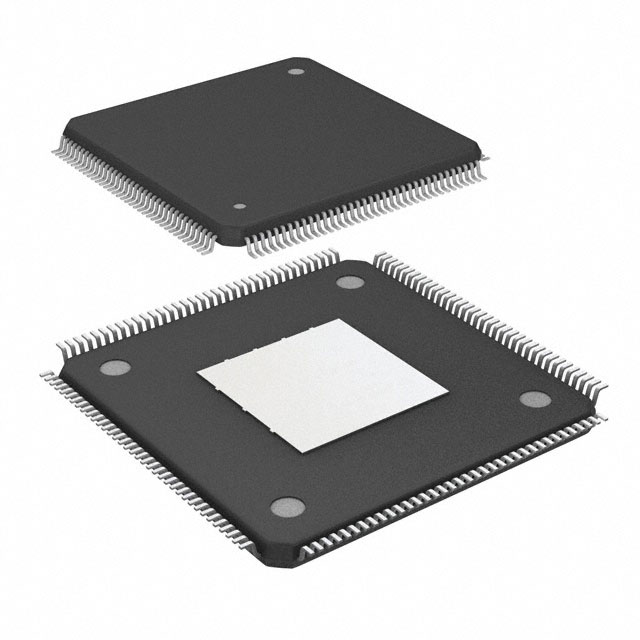Vedi le specifiche per i dettagli del prodotto.

EP4CE10E22C8L
Product Overview
- Category: Programmable Logic Device (PLD)
- Use: EP4CE10E22C8L is a PLD that can be programmed to perform various logic functions.
- Characteristics: It offers high performance, low power consumption, and flexibility in designing digital circuits.
- Package: The EP4CE10E22C8L comes in a compact LQFP package.
- Essence: It is designed to provide a cost-effective solution for implementing complex digital systems.
- Packaging/Quantity: The EP4CE10E22C8L is typically sold in reels containing multiple units.
Specifications
- Logic Elements: 10,080
- Embedded Memory: 414,720 bits
- Maximum User I/Os: 346
- Operating Voltage: 1.2V
- Speed Grade: C8 (Commercial grade, operating frequency up to 300 MHz)
Detailed Pin Configuration
The EP4CE10E22C8L has a total of 346 pins, which are divided into different categories such as input/output pins, power pins, and configuration pins. The pin configuration diagram provides detailed information about the function and location of each pin.
Functional Features
- High Performance: The EP4CE10E22C8L offers fast operation speeds, making it suitable for applications requiring real-time processing.
- Flexibility: It can be reprogrammed multiple times, allowing designers to modify the functionality of the device without changing the hardware.
- Low Power Consumption: The device is designed to minimize power consumption, making it suitable for battery-powered applications.
- Versatility: The EP4CE10E22C8L supports a wide range of digital logic functions, including arithmetic operations, data storage, and control logic.
Advantages and Disadvantages
Advantages: - High performance and flexibility - Low power consumption - Cost-effective solution for complex digital systems
Disadvantages: - Limited number of I/O pins compared to higher-end PLDs - Programming and debugging can be complex for beginners
Working Principles
The EP4CE10E22C8L is based on a Field-Programmable Gate Array (FPGA) architecture. It consists of configurable logic blocks, embedded memory, and programmable interconnects. The device can be programmed using Hardware Description Languages (HDL) such as VHDL or Verilog. Once programmed, the EP4CE10E22C8L executes the desired logic functions by routing signals through the configurable logic blocks and interconnects.
Detailed Application Field Plans
The EP4CE10E22C8L finds applications in various fields, including:
- Embedded Systems: It can be used to implement complex control systems in embedded devices such as industrial automation, robotics, and automotive electronics.
- Communications: The device can be utilized in networking equipment, enabling high-speed data processing and protocol handling.
- Signal Processing: It is suitable for implementing digital signal processing algorithms in applications like audio/video processing and image recognition.
- Test and Measurement: The EP4CE10E22C8L can be employed in test and measurement instruments, providing flexible and customizable functionality.
Detailed and Complete Alternative Models
- EP4CE6E22C8N: Similar to EP4CE10E22C8L but with fewer logic elements and I/O pins.
- EP4CE15E22C8L: Higher-end model with increased logic elements and I/O pins.
- EP4CE30E22C8N: Enhanced version with more embedded memory and higher operating frequency.
These alternative models offer different capabilities and can be chosen based on the specific requirements of the application.
Word count: 420 words
10 domande e risposte comuni relative all'applicazione di EP4CE10E22C8L nelle soluzioni tecniche
Sure! Here are 10 common questions and answers related to the application of EP4CE10E22C8L in technical solutions:
Q: What is EP4CE10E22C8L? A: EP4CE10E22C8L is a field-programmable gate array (FPGA) chip manufactured by Intel (formerly Altera). It offers programmable logic, memory, and digital signal processing capabilities.
Q: What are some typical applications of EP4CE10E22C8L? A: EP4CE10E22C8L can be used in various applications such as industrial automation, robotics, telecommunications, automotive systems, medical devices, and many more.
Q: How does EP4CE10E22C8L differ from other FPGAs? A: EP4CE10E22C8L is part of the Cyclone IV series and offers a balance between cost, performance, and power consumption. It has a relatively low power consumption compared to higher-end FPGAs.
Q: Can EP4CE10E22C8L handle high-speed data processing? A: Yes, EP4CE10E22C8L supports high-speed data processing with its embedded multipliers, dedicated memory blocks, and high-speed I/O interfaces.
Q: Is EP4CE10E22C8L suitable for real-time applications? A: Yes, EP4CE10E22C8L can be used in real-time applications due to its ability to process data in parallel and its support for fast I/O interfaces.
Q: Can EP4CE10E22C8L be reprogrammed after deployment? A: Yes, EP4CE10E22C8L is a reprogrammable FPGA, allowing for flexibility and the ability to update the design without replacing the chip.
Q: What development tools are available for programming EP4CE10E22C8L? A: Intel Quartus Prime is the recommended software tool for designing, simulating, and programming EP4CE10E22C8L. It provides a comprehensive development environment.
Q: Are there any limitations to consider when using EP4CE10E22C8L? A: EP4CE10E22C8L has limited resources compared to higher-end FPGAs, so complex designs may require more advanced chips. Additionally, power consumption should be considered in low-power applications.
Q: Can EP4CE10E22C8L interface with other components or microcontrollers? A: Yes, EP4CE10E22C8L can interface with other components or microcontrollers through various communication protocols such as SPI, I2C, UART, and GPIO.
Q: Where can I find additional resources and support for EP4CE10E22C8L? A: Intel (formerly Altera) provides documentation, application notes, reference designs, and an active online community where you can find additional resources and support for EP4CE10E22C8L.

